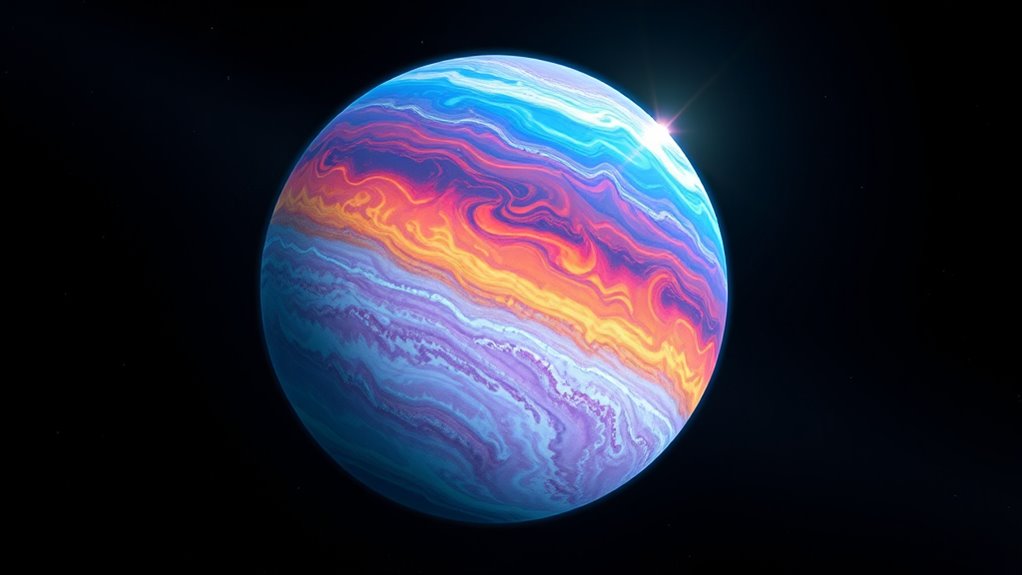The James Webb Space Telescope has uncovered a new class of smaller, colder planets that were previously hard to detect. These worlds orbit young stars and often reside within dusty debris disks, making them difficult for earlier telescopes to see. One notable discovery is TWA 7b, a planet roughly the size of Saturn, offering clues about diverse planet formation. Explore further to understand how JWST is changing our view of the universe’s planetary diversity.
Key Takeaways
- JWST enables direct imaging of smaller, colder exoplanets previously hidden from view.
- It detects planets within debris disks, indicating active planet formation around young stars.
- The discovery of TWA 7b reveals a new class of smaller, Earth-like, and potentially habitable planets.
- JWST uses mid-infrared coronagraphy to suppress stellar glare, revealing faint planetary signals.
- These advancements expand our understanding of diverse planetary types beyond traditional detection methods.

Have you ever wondered what kinds of planets the James Webb Space Telescope can find? Thanks to its advanced instruments and imaging techniques, it’s now capable of discovering a new class of exoplanets that were previously hidden from view. One of the most exciting breakthroughs is the direct imaging of a planet candidate called TWA 7b, which is roughly the size of Saturn and orbits a young red dwarf star about 34 to 111 light-years away. This isn’t just any planet; it’s potentially the lightest exoplanet ever directly imaged outside our solar system, boasting a mass around 100 times that of Earth. The key to this discovery was the use of mid-infrared coronagraphy, which suppresses the glare from the host star, allowing faint planetary signals to emerge. This technique signals a shift in exoplanet detection from indirect methods to direct imaging, opening the door to studying planets more like those in our own neighborhood.
James Webb’s direct imaging reveals the faint, potentially Earth-like exoplanet TWA 7b orbiting a nearby red dwarf star.
TWA 7b orbits at a distance about 50 times that between Earth and the Sun, placing it within the debris disk that surrounds its star. This disk, filled with concentric dust rings, hints at a dynamic environment where planet formation might still be ongoing. The planet’s estimated temperature is around 120°F (49°C), which falls within a range that could, under some conditions, support life. Its relatively young age—about 6.4 million years—means it’s still cooling and evolving, unlike older gas giants or hot Jupiters that are often imaged. Its environment offers clues about how planets form around low-mass stars and how debris disks influence planetary development. Infrared observations have been crucial in detecting and studying these faint worlds, expanding our understanding of planetary diversity. Moreover, advancements in high-contrast imaging techniques have greatly enhanced our ability to observe such elusive planets directly.
The detection of TWA 7b highlights the presence of a new type of planet: smaller, colder, and potentially more similar to Earth than the massive gas giants traditionally imaged. These planets are often found orbiting young, low-mass stars with extensive debris disks, suggesting that planet formation in such systems could be more common and diverse than previously thought. The JWST’s ability to spot these planets stems from its powerful Mid-Infrared Instrument, combined with high-contrast imaging that reduces stellar glare. This allows astronomers to isolate faint infrared signals from planets embedded within dusty environments, overcoming past limitations faced by telescopes that relied on indirect detection methods like gravitational lensing or radial velocity measurements.
In essence, JWST is revealing a universe teeming with a broader variety of planetary types. Its sensitivity to smaller, cooler planets hints at the possibility of finding worlds more akin to Earth—planets that might, under the right conditions, support life. This breakthrough pushes astronomy into a new era where understanding planet formation, diversity, and habitability becomes more precise, promising a future filled with discoveries of worlds previously concealed in the cosmic dust.
Frequently Asked Questions
How Do Jwst’s Findings Influence Current Planetary Classification Systems?
Your current question explores how JWST’s discoveries reshape planetary classification. You should know that JWST’s ability to directly image lower-mass planets and those embedded in debris disks pushes scientists to refine existing systems. You’ll find that classifications now consider a planet’s environment, formation history, and atmospheric features, not just size and orbit. This broader approach helps you better understand diverse planetary types and their roles in system evolution.
Can JWST Detect Signs of Life on New Planet Types?
Imagine peering through a cosmic window, searching for whispers of life. With JWST’s advanced tools, you can detect gases like methane and carbon dioxide—signs of possible biology—especially in hydrogen-rich atmospheres. While it might miss oxygen, these indirect clues let you glimpse potential life. By analyzing atmospheric compositions during planetary transits, you get a chance to uncover life’s signatures on distant worlds, expanding your understanding of the universe’s living possibilities.
What Challenges Does JWST Face When Analyzing Distant Planets?
You face several challenges when analyzing distant planets with JWST. Its sensitive detectors need extreme stability to capture faint signals without interference. Stellar activity from host stars can contaminate data, making it hard to identify planetary atmospheres. The vast distances weaken signals and add complexity, especially for planets with thick or diverse atmospheres. Additionally, limited observation windows and the need for advanced modeling complicate accurate interpretation of the data.
How Do These New Planet Types Affect Our Understanding of Planetary Formation?
You see, these new planet types show that planetary formation is more diverse than we once thought. You learn that small, cold planets can form early, even amid debris disks, and that planets influence their environments, shaping disk structures. This broadens your view, suggesting planet formation occurs across various conditions and sizes, challenging older models focused mainly on massive planets and highlighting the complexity of how planetary systems develop.
Will These Discoveries Impact Future Space Exploration Missions?
These discoveries will definitely impact future space exploration missions. You’ll see more targeted efforts to image and study exoplanets directly, focusing on their atmospheres and potential habitability. Improved technology like coronagraphs and spectroscopy will guide mission designs, helping you identify promising worlds for detailed exploration. As a result, you’ll be able to prioritize missions that aim to find Earth-like planets and better understand planetary systems beyond our solar system.
Conclusion
As you explore these new planet types discovered by the James Webb Telescope, remember that each one offers a glimpse into the universe’s diversity. Imagine finding a planet with conditions perfect for life, just like a real exoplanet candidate scientists are studying now. It reminds you that every discovery brings us closer to understanding our place in the cosmos. Keep looking up—you never know what incredible worlds are waiting to be uncovered just beyond our reach.










